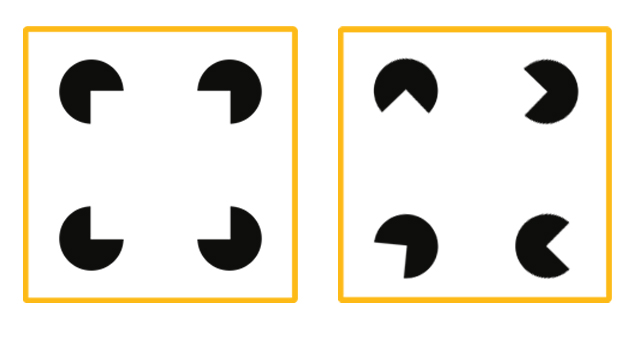Children With Autism ‘See’ This Optical Illusion in a Unique Way, Experiment Finds
To transform reality into the mental landscape that occupies out minds, our brain performs a multitude of operations. Some are short-cuts; assumptions that become obvious the moment we attempt to make sense of the conflict presented in an optical illusion.
For individuals with autism, those short cuts and mental operations could work a little differently, subtly influencing how the brain constructs a picture of everyday life.
With this in mind, scientists have turned to optical illusions to better understand neurodivergence.
A study on the brain activity of 60 children, including 29 diagnosed with autism spectrum disorder ( ASD), suggests differences in way individuals process illusory shapes could reveal ways autism affects specific processing pathways in the brain.
The research made use of a classic style of illusion popularized by the Italian psychologist, Gaetano Kanizsa, which typically involve simple lines or shapes, such as circles, with sections removed. Arranged in a certain way, the empty spaces align to describe a second shape in their negative space.
To really ‘see’ the different shapes, higher processing operations in different areas of the brain combine stimuli, turning a mere pattern of dark and light into a comprehensive picture.
Depending on the information that’s recruited, the stimuli can be interpreted as one shape or the other, but not both at once.

The whole process is highly dependent on neurons sharing information quickly, from the parts of the brain that determine perception to the parts that receive and package visual data, and back again.
Autism is defined as a neurological ‘spectrum disorder’ because its traits are extremely diverse, with each person showing different abilities, strengths, and challenges.
Generally, however, research has shown that many people with ASD process sensory information, like sound and sight, in a way that is not neurotypical.
An optical illusion is a good way to explore that neurodivergence.
A study in 2018, for instance, found that some individuals with ASD struggle to switch back-and-forth between seeing a moving object and seeing color. In a general sense, it appeared that their brains were zooming in on the details and neglecting the larger picture.
In the current study, a similar trend was noticed. When kids were seated on a chair with an electroencephalogram attached to their scalps, they were asked to focus on a central dot against a gray background on a screen in front of them, and press a button when the dot changed from red to green.
The screen also featured four contouring images, either randomly placed or aligned in such a way that the negative space between them described a shape.
Asking them to focus on the dot rather than the negative spaces ensured participants were ‘passively’ observing the illusion in front of them and not actively trying to ‘solve’ it.
Based on their brain activity, children aged from 7 to 17, who had been diagnosed with ASD, demonstrated a delay in processing the Kanizsa illusion.
This doesn’t necessarily mean that the participants couldn’t discern the shape formed by the contouring images, but it does suggest that their brains processed the illusion in a way that isn’t automatic.
“When we view an object or picture, our brains use processes that consider our experience and contextual information to help anticipate sensory inputs, address ambiguity, and fill in the missing information,” explains neuroscientist Emily Knight from the University of Rochester.
“This tells us that these children may not be able to do the same predicting and filling in of missing visual information as their peers. We now need to understand how this may relate to the atypical visual sensory behaviors we see in some children on the autism spectrum.”
For instance, another study by Knight published last year found that children with ASD struggle to process body language if they aren’t paying close attention.
When actively watching the color of moving dots on a screen, the brain waves of those with ASD did not interpret the image as a walking human, as it was intended.
“If their brain is processing body movements less, they might have a harder time understanding other people, and need to pay extra attention to body language in order to see it,” said Knight in a press release from last year.
“Knowing this can help guide new ways to support people with autism.”
In the future, Knight hopes to continue her research among larger cohorts, including those who have a wider range of verbal and cognitive abilities. Her ultimate goal is to find new and better ways to support kids and adults on the autism spectrum.
The study was published in the Journal of Neuroscience.
